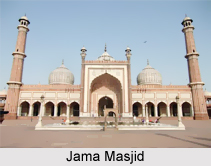 Islamic Sculptures in India evolved by following the idioms of both the Persian art and the ancient Hindu art and sculpture. In fact it was with the invasion of the Muslim and the emergence of Delhi Sultanates that the Islamic sculpture and Islamic architecture came into vogue.
Islamic Sculptures in India evolved by following the idioms of both the Persian art and the ancient Hindu art and sculpture. In fact it was with the invasion of the Muslim and the emergence of Delhi Sultanates that the Islamic sculpture and Islamic architecture came into vogue.
History of Islamic Sculpture
Muslims derived their exclusive style from synthesizing the arts of the Byzantines, the Copts, the Romans and the Sassanids. The 8th-century desert palace Khirbat al-Mafjar discloses a wealth of carved and moulded decoration, sculptured stone reliefs and figural fresco paintings. There is a distinct style in India which preserved chiefly in architecture, developed after the Delhi Sultanate was established. This art made broad use of stone and reflected Indian variation to Islam rule, until Mughal art replaced it in the 17th century. The square Char Minar with large arches, arcades and minarets is illustrative.
Features of Islamic Sculpture
Geometrics are very popular and are a main belief and cultural force which appear in the private palaces and buildings. The Islamic art does not contain any representations of humans or animals.
So far the Islamic sculptures stand out with their intricate carvings and details. Plants sculpture; animal and human motifs and calligraphy are important features of the Islamic sculptures. In fact the Indo Islamic sculptures are scattered everywhere in India and speak volumes about their popularity.
Works of Islamic Sculpture
There are number of sculptures made by the Islamic rulers and these are -
| Sculpture of Haji Ali Dargah, Mumbai | Sculpture of Chirag-i-Delhi-Dargah, New Delhi | Sculpture of Bibi Ka Maqbara |
| Sculpture of Jama Masjid, New Delhi | Sculpture of Chauburji Masjid, New Delhi | Sculpture of Bibi Ka Maqbara, Aurangabad |
| Sculpture of Atala Masjid, Jaunpur | Sculpture of Dargah Qutub Sahib, New Delhi | Sculpture of Kamar Ali Darvesh Dargah, Pune |
| Sculpture of Ajmer e Sharif, Ajmer | Sculpture of Hauz-i-Shamsi, New Delhi | Sculpture of Dargah of Sayeed Burhan-Ud-Din, Aurangabad |
| Sculpture of Jumma Masjid - Bijapur | Sculpture of Hazrat Nizamuddin Auliya, New Delhi | Sculpture of Dargah of Baba Shah Muzaffar, Aurangabad |
| Sculpture of Dargah of Bu Ali Shah Qalandar, Panipat | Sculpture of Idgah, New Delhi | Sculpture of Thousand Light Mosque, Chennai |
| Sculpture of Kabuli Bagh Mosque or Babur"s Mosque, Panipat | Sculpture of Jamali Kamali Mosque, New Delhi | Sculpture of Big Mosque, Chennai |
| Sculpture of Lat-Ki Masjid, Hissar | Sculpture of Kalu Saraj Masjid, New Delhi | Sculpture of Nagore Dargah, Nagappattinam |
| Sculpture of Pathar Masjid, Kurukshetra | Sculpture of Khirki Ki Masjid, New Delhi | Sculpture of Moti Masjid, Agra |
| Sculpture of Solah Khamba Mosque | Sculpture of Madhi Masjid, New Delhi | Sculpture of Jawab Masjid, Agra |
| Sculpture of Jama Masjid, Gulbarga | Sculpture of Moth Ki Masjid, New Delhi | Sculpture of Jami Masjid, Agra |
| Sculpture of Khwaza Bande Nawaz Dargah, Gulbarga | Sculpture of Nilli Masjid, New Delhi | Sculpture of Kanjiramattom Mosque, Kochi |
| Sculpture of Chote Hazrat Ki Dargah, Hyderabad | Sculpture of Palam Mosque, New Delhi | Sculpture of Jama-at Mosque, Malappuram |
| Sculpture of Deval Masjid, Nizamabad | Sculpture of Quwwat ul Islam Mosque, New Delhi | Sculpture of Malik Dinar Mosque, Kasaragod |
| Sculpture of Jama Masjid, Hyderabad | Sculpture of Sunehri Masjid, New Delhi | Sculpture of Ottapalam Juma Masjid, Palakkad |
| Sculpture of Jumma Masjid, Kurnool | Sculpture of Jumma Masjid, Ahmedabad | Sculpture of Beemappalli, Thiruvananthapuram |
| Sculpture of Mecca Masjid, Hyderabad | Sculpture of Siddi Sayed`s Mosque, Ahmedabad | Sculpture of Nakhoda Mosque, Kolkata |
| Sculpture of Pathar Ki Masjid, Patna | Sculpture of Cheraman Juma Masjid, Thrissur | Sculpture of Gulbarga Fort Mosque, Bijapur |
| Sculpture of Sher Shah Suri Masjid, Patna | Sculpture of Muhammad Shah, Kochi | Sculpture of Imambara at Hooghly, Kolkata |
| Sculpture of Abdu Nabi`s Mosque, New Delhi | Sculpture of Pazhayangadi Mosque, Malappuram | Sculpture of Rauza Sharif, Sirhind, Patiala |
| Sculpture of BegamPuri Masjid, New Delhi | Sculpture of Madayi Mosque, Kannur | Sculpture of The Moorish Mosque, Kapurthala |



















